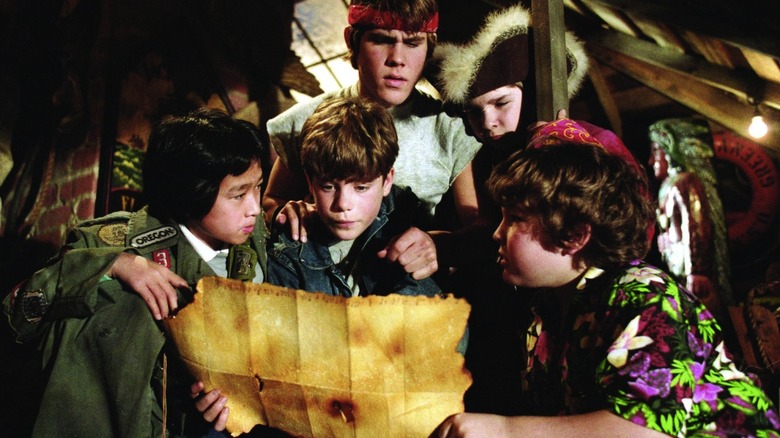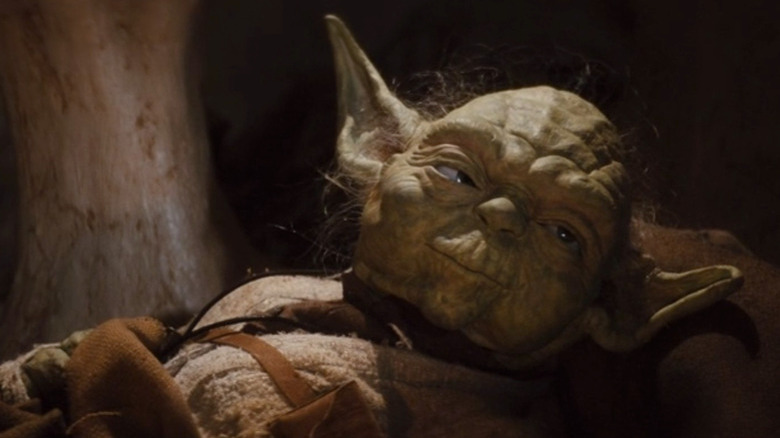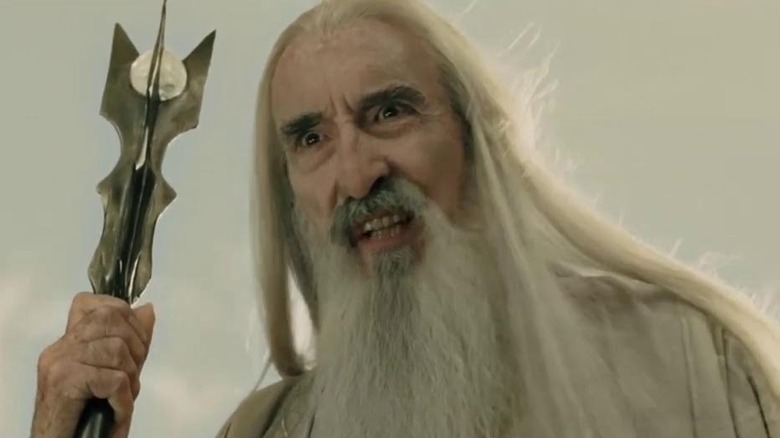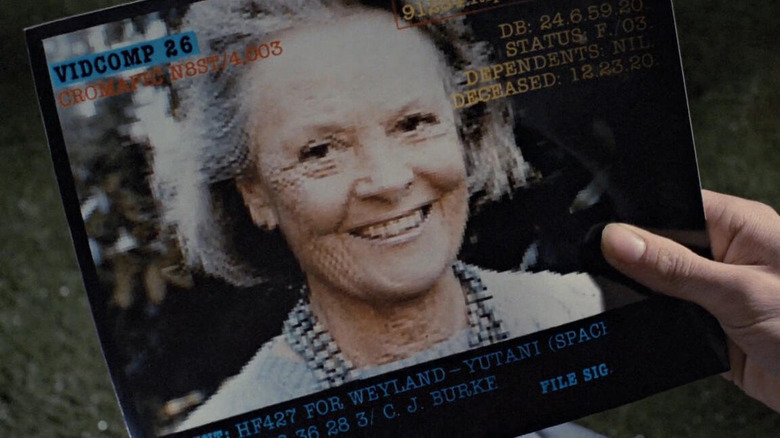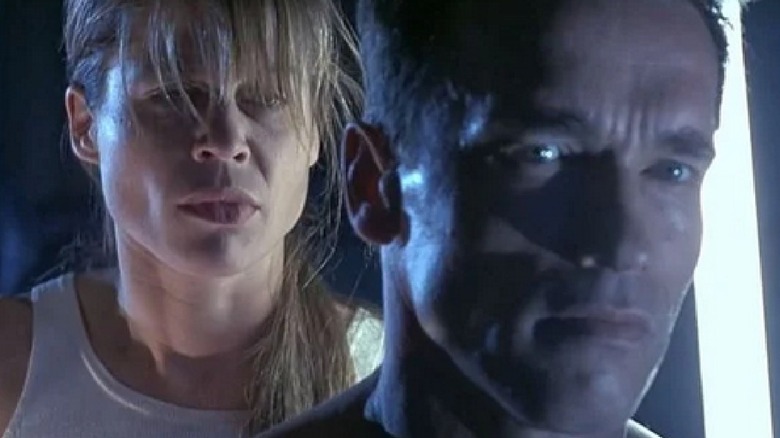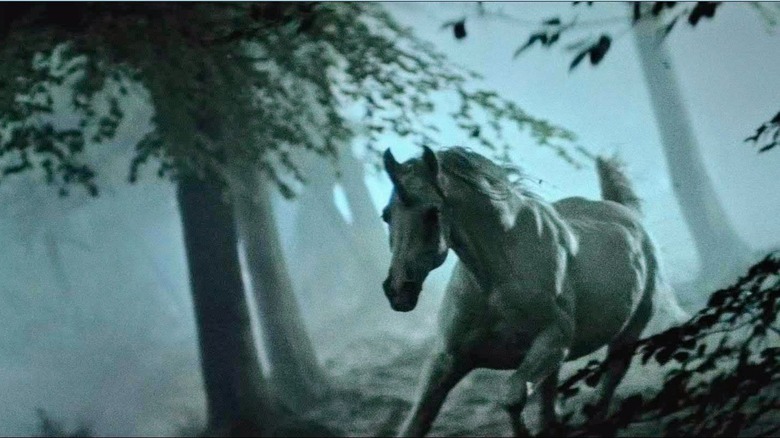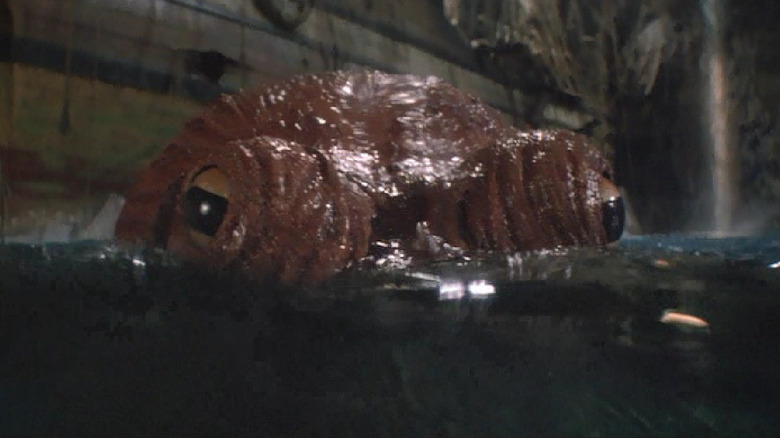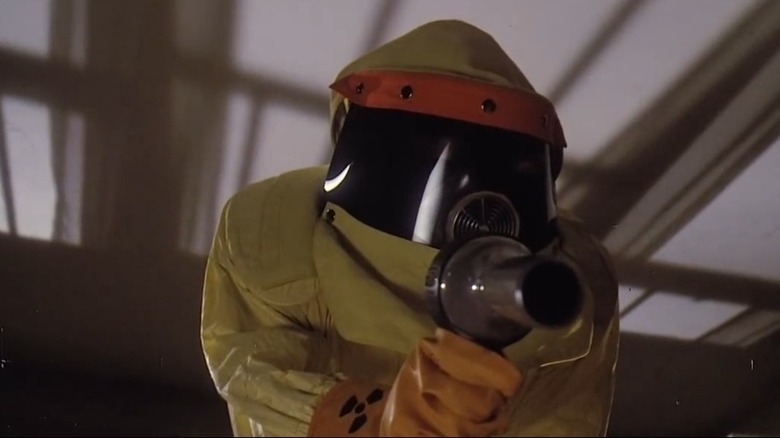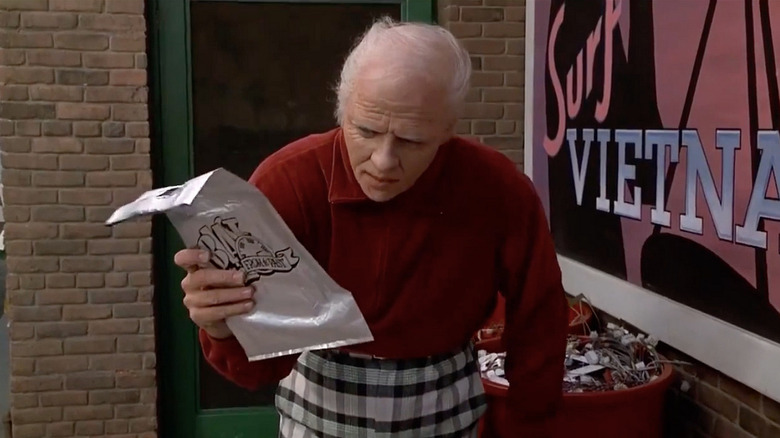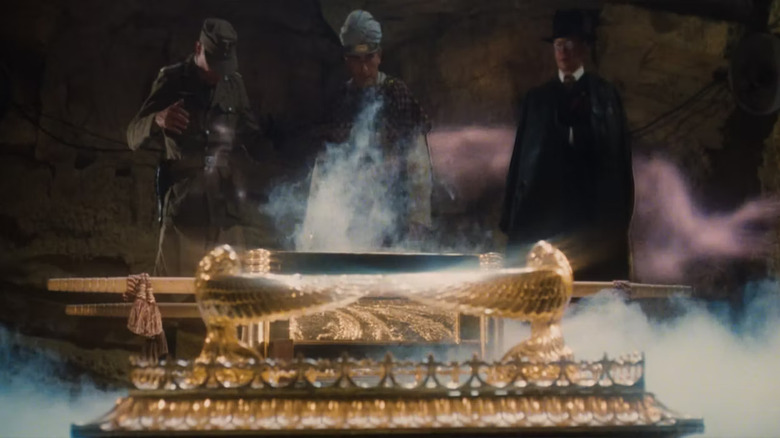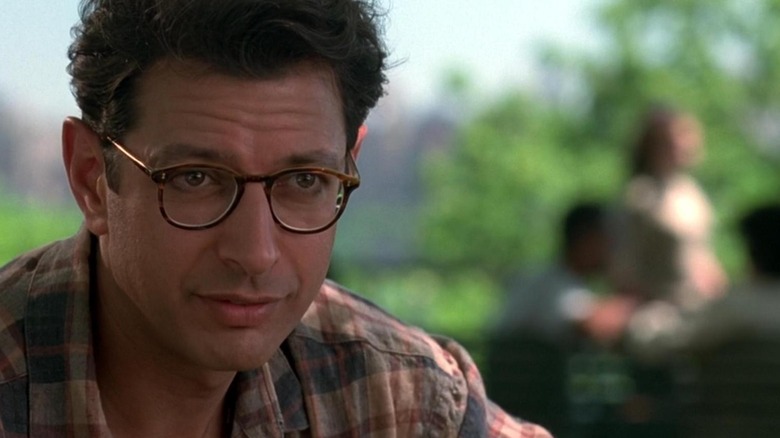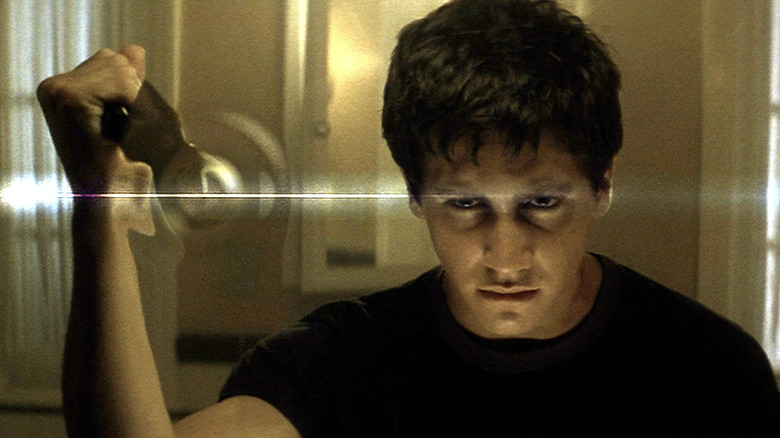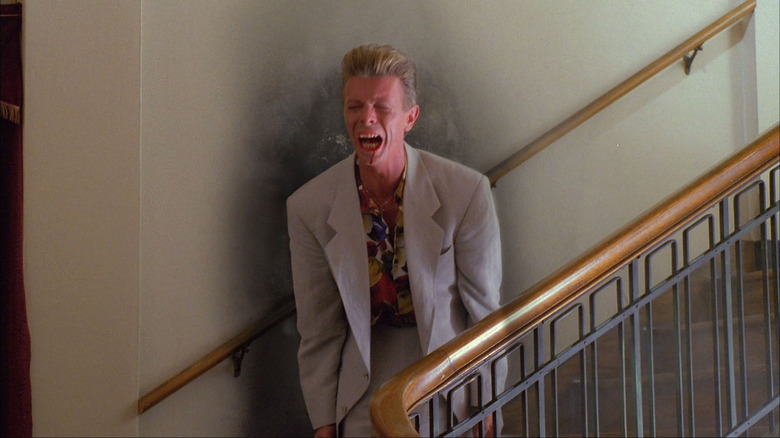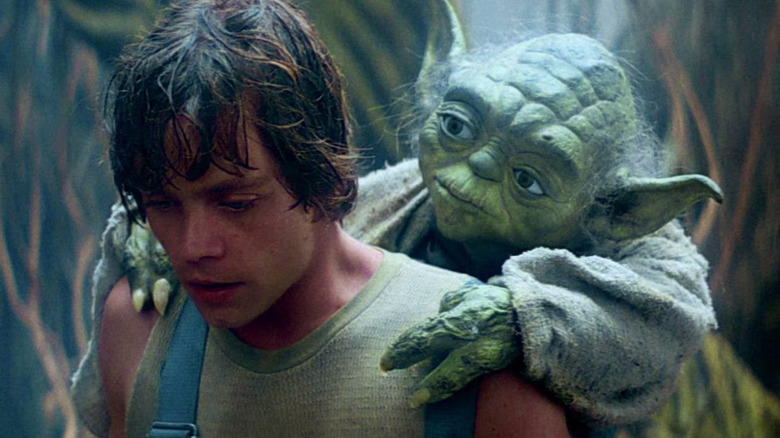Deleted Movie Scenes That Would Have Filled Major Plot Holes
Big-budget movies today are carefully manicured and manufactured to not have plot holes. In our cinema sins era, studios know what happens when fans start poking holes in a new release: movies such as "The Rise of Skywalker" get made, for starters. Back in the day, however, even the best movies from the "Star Wars" franchise and other major properties like "Back to the Future" and "Indiana Jones" were full of tiny holes and small details that didn't make sense. But as it turns out, many of these are the result of a scene that was written, or even filmed, that ultimately didn't make it into the final edit.
Cinema history is full of classics with deleted scenes that would have filled major and minor plot holes. Oftentimes, this is done by necessity, in order to shorten a film's runtime or as a reaction to an audience test screening. Scenes that were considered essential in the script sometimes end up getting left on the cutting room floor after shooting and editing.
These scenes all would have made these classic Hollywood blockbusters make more sense to audiences — and some even did — making their way into director's cuts and DVD bonus features.
Star Wars Episode VI: Return of the Jedi
For years, fans have blamed Obi-Wan Kenobi for never telling Luke Skywalker (Mark Hamill) the truth about his parentage. Despite being one of the only people in the galaxy to know the truth about Darth Vader, he chooses to withhold the identity of Luke's father. Apparently, this was a direct order from Yoda. That's something we didn't know until this deleted scene saw the light of day.
In a deleted scene, we get to see an extra moment that Yoda and Luke share before the master's death. In an extension of the speech that he gives before he fades, Yoda tells Luke that "Obi-Wan would have told you long ago, had I let him." This line was eventually cut, but for fans, it changes everything.
No longer can we blame Obi-Wan for not telling Luke about Anakin. All other portrayals of the character since have only reinforced the idea that Obi-Wan would have told Luke everything eventually. Now we know that "eventually" was a time not determined by Obi-Wan, but by Yoda.
The Lord of the Rings: Return of the King
One of the most pivotal scenes in Peter Jackson's "Lord of the Rings" trilogy was deleted from the final installment. Even without Saruman's death scene, the theatrical cut of "Return of the King" was already over three hours. While the third installment still won every single Academy Award it was nominated for, "LotR" fans were not fully satisfied until they saw this crucial plot point depicted in the extended edition of "Return of the King."
Saruman (Christopher Lee) is one of the main antagonists in the "Lord of the Rings" trilogy, second only to Sauron. The scene in question takes place when Gandalf (Ian McKellen) and company finally make it to Saruman's tower after the Ents have destroyed Isengard (at the end of "The Two Towers") in another sequence that was left out of the original theatrical release.
In the scene, Gandalf and the good guys look up at Saruman as he refuses to leave his tower and surrender. His servant, Grima Wormtongue (Brad Dourif), then stabs him and is immediately shot by Legolas (Orlando Bloom). Both the villains fall, and Saruman lands on a spike of the tower's water wheel. It's a pretty gruesome end for the villain, even by "LotR" standards.
However, some fans think this death is over-the-top and doesn't capture the ending of Saruman's arc from the books. Even Peter Jackson himself feels the movie works better without it.
Aliens
"Aliens" isn't begging for a deeply emotional motivation to pull its lead character, Ripley (Sigourney Weaver) through the bloody, Alien-splattered halls of James Cameron's action-sci-fi masterpiece. However, there is one deleted scene that does make the movie better and helps round out the main character of the "Alien" franchise.
In the scene in question, Ripley awakens from stasis and one of the first things she does is ask about her daughter. Carter Burke (Paul Reiser) tells her that her daughter passed away two years ago at the age of 66. In response, a broken Ripley says, "I promised her I'd be home for her birthday. Her 11th birthday."
This puts into perspective a great deal of things about "Aliens." One of these aspects is the time that passed between movies, but another is the time dilation that Ripley has experienced. While she, may not have physically aged, she remained in total stasis for half a century. Something like that is bound to mess someone up, even someone as mentally tough as Ellen Ripley. This context provides a serious physiological motivation for Ripley that isn't present in the theatrical cut of the movie.
Terminator 2: Judgment Day
As it turns out, there is a key piece of "Terminator" lore hidden in the deleted scenes of "Terminator 2: Judgment Day." In fact, this information would have changed everything about the sequels moving forward, especially "Terminator: Dark Fate."
In this universe, Terminators become increasingly human the more they interact with humans. Terminators gain knowledge and empathy through this interaction, and canonically, this is how they turn good. This logic spawns from a line in "Terminator 2: Judgment Day" where Schwarzenegger says, "The more contact I have with humans, the more I learn." However, this line wasn't in the original scene as it was shot.
Instead, the scene went on for several minutes, and the question had a more technically complex answer. John (Edward Furlong) discovers that Terminators have a switch in their learning computer chip that needs to be manually flipped to switch from read-only to write access. John and Sarah (Linda Hamilton) open up the T-800's brain and flip this switch, making for a pivotal moment in the "Terminator" lore that audiences didn't get to see until the special edition of "Terminator 2: Judgment Day" was released.
The scene also further grounds John's sense of empathy, showing him successfully convincing his mother to let the Terminator live, believing in their ability to humanize it.
Blade Runner
Anyone who considers themselves even a casual "Blade Runner" fan is likely aware of the difference between the various cuts of the movie. The Unicorn dream scene that was eventually included in full in "The Final Cut" is one of the most important of these deleted scenes. In some ways, it is the key to solving "Blade Runner," if such a thing even exists. This deleted scene answers the question of the meaning of the origami unicorn at the end of the film and answers the film's biggest ambiguity: is Deckard a Replicant?
Not only does this extended sequence refer back to the novel the movie was based on, but in doing so, it answers the film's primary mystery. In it, Deckard (Harrison Ford) is daydreaming about a unicorn running through a forest. Right before his escape, Deckard comes across a tiny, folded origami unicorn on the ground, presumably left by his partner Gaff (Edward James Olmos).
You have to connect the dots to ultimately put together who left the origami for Deckard and what it means. The understanding is that Deckard is a Replicant based on Gaff's knowledge of his memories, implying his memories are implanted and not his own.
The Goonies
In the final scene of the "The Goonies," reporters surround them and ask all about their various escapades, which include a reference to "the octopus." Those who watched closely may ask, "What octopus?" since there was none in the movie itself. It turns out this plot hole mistake was a product of a misbegotten sequence that would have explained the whole thing if only it made the film's final cut.
In this deleted scene, the kids are attacked by an octopus on their way to find the pirate treasure. It is a perilous scene, but one that ultimately bore little consequence on the film's overall plot. It actually makes sense that this one got cut, but unfortunately, there is still mention of the scene later on, opening it up to become a plot hole, though perhaps this is open to interpretation.
While some might call it a plot hole, others may call it an inside joke by the filmmakers. Either way, this deleted scene ended up being way more important than any of the writers could have imagined.
Back to the Future
"Back to the Future" fans have been combing the movie (and its sequels, but more on that later) from front to back for decades and finding more small details as well as little things that don't make sense. One of the mistakes they have pointed out is that during the movie's infamous send-up to contemporary science fiction, Marty McFly (Michael J. Fox) dresses up in a yellow suit while using a hair dryer as a space weapon to intimidate his teenage father. He says he is "Darth Vader "from the planet "Vulcan," though this is not what fans take issue with. The problem is that after this joke, the hair dryer completely disappears. If you watch the original scene, you'll see the lack of continuity when it comes to this item.
As it turns out, this "mistake" was simply a sacrifice that had to be made in the editing room. The original "Darth Vader" sequence was going to be quite a bit longer, but was cut as a time-saving measure. In this version of the scene, the continuity makes a lot more sense, and while we still don't see him put it down the frame, the hair dryer's inclusion is justified.
Back to the Future Part II
In the sequel to "Back to the Future," Marty and Doc Brown (Christopher Lloyd) revisit the events of the first movie in one of the first meta blockbusters. Like its predecessor, it's full of action and heart, but it also has a big hole that is filled by a deleted scene. This one is a bit more important to the plot than a hairdryer though, since it concerns the death of (a version of) one of the franchise's most important characters.
In "Back to the Future Part II," a 2015-era Biff (Thomas F. Wilson) is the instigator of the plot when he steals the DeLorean and travels back to 1955 to give his younger self the Sports Almanac. Old Biff is seen later in the movie landing the car back in the 2015 timeline and stumbling out of the vehicle a withered and broken man. As it turns out, there is a deleted scene that explains what happened to Old Biff.
In the scene, as Marty and Doc fly away, Biff disintegrates into nothing, getting his comeuppance for messing with the timeline in the first place. This bit was likely deleted due to how it contradicts and complicates the time travel explanations given by Doc Brown in the movie.
Raiders of the Lost Ark
At the end of "Raiders of the Lost Ark," Indiana Jones (Harrison Ford) tells Marion (Karen Allen) not to look at the activated Ark of the Covenant. Our heroes shut their eyes tight as spirits fly out of the Ark and give the greedy, evil Nazis the comeuppance they deserve. Nitpicky fans over the years have come to ask exactly how Indy knew not to look. The answer, as it turns out, lies in an unfilmed scene.
In the original script for "Raiders," there were a few lines of dialogue toward the beginning of the film that very explicitly explained to the characters and the audience what would happen should anyone choose to touch or lay their eyes upon the Ark. When Indy and Sallah (John Rhys-Davies) first find Imam (Tutte Lemkow), he tells them of the Ark's power and warns them of the rules. Later, in another related cut scene, before Sallah removes the Ark from the Well of the Souls, Indy reminds him of Imam's warning. Both these scenes were quite explanatory, perhaps overly so since they didn't make the final edit.
Without this context, there is a much more moralistic bent to the ending. Indy's goodness and intuition lead him to the right solution in the situation. Instead of just remembering something a character told him, he had to put the pieces together himself, which is arguably a more rewarding conclusion.
Independence Day
"Independence Day" might have been a bonafide box office hit thanks to its genre-defining blend of sci-fi and action, but it certainly had its critics. Nonetheless, the film has endured, but nothing today makes less sense than the movie's nonsensical ending. In it, David (Jeff Goldblum), a satellite engineer, codes a computer virus that disrupts the invading aliens' lines of communication. This ends up giving humanity the upper hand in the climactic battle, but it all feels like a bit of a deus ex machina, doesn't it?
That's because of a missing "Independence Day" scene that explores Goldblum's character in more detail. In this deleted scene, David visits Area 51 and is seen investigating an alien ship. It's here that he discovers how the aliens communicate and the frequency of their computer communications. He hypothesizes a computer virus could counter their efforts. We can extrapolate from this scene that he had a bit of a heads-up, and started working on countermeasures at this point in the movie. Audiences in 1996 didn't have that bit of context, so they just went along for the ride.
Donnie Darko
"Donnie Darko" is a classic movie with an infamous director's cut. Richard Kelly's re-edit of his psychological horror movie and actor Jake Gyllenhaal's breakout was released in 2004, shortly after the film had started to accrue a following. In the deleted content, there is an entire world's worth of lore and a layer of story that doesn't come through at all in the theatrical cut.
The "Donnie Darko" director's cut adds a great deal of explanatory scenes that flesh out the science fiction aspect of the story. Some fans say this ruins the movie by taking all the mystery out of it. But for others who find the need for it to all make some sort of sense, they will find the director's cut the far more rewarding watch.
The cut includes passages from "The Philosophy of Time Travel," a fictional book that explains the cosmic forces behind the events of "Donnie Darko." During these sequences, Kelly introduces us to a bunch of proper nouns that, if you squint hard enough, explain everything. However, those who do not wish to engage with the convoluted elements of "Donnie Darko" will always have the theatrical cut.
Twin Peaks: Fire Walk with Me
There is actually more than one deleted scene in "Twin Peaks: Fire Walk with Me" that contains information crucial to the plot. Director David Lynch was known for making cryptic films, and half of the context for the movie is in the show in the first place that viewers just kind of take for granted the parts of "Fire Walk with Me" that don't make any sense. However, if you were to take a gander at the deleted scenes that are included in "Twin Peaks: The Missing Pieces," you will realize there are more answers than you may have otherwise thought.
Of course, we can't just recap this deleted scene, because "Twin Peaks: The Missing Pieces" is an entire 90-minute feature that has been edited together from deleted and extended content from "Fire Walk with Me." The end result has a good deal of overlap, but there is a ton of new information about Laura and Leland Palmer in "The Missing Pieces" that you can't get anywhere else.
These scenes previously weren't seen until the feature was released in 2014, a few years before "Twin Peaks: The Return." You are still going to have to work to fit the pieces into the puzzle, but it wouldn't quite be a David Lynch movie if you didn't.
Star Wars Episode V: The Empire Strikes Back
It is tough to deny that "The Empire Strikes Back" is close to a perfect movie. However, an unfilmed training scene that was originally in the movie would have fixed one of its weirdest small moments that many viewers probably haven't thought twice about.
In the sequence at the end of "Empire" where Luke finally confronts Darth Vader, audiences at the time got their first glimpse at one of the Jedi's key powers: the Force jump. In this climactic battle, we see Luke high jump for the first time as he avoids Vader's relentless attacks. Only the most critical of fans will see the hole, however. Just how did Luke learn to do this?
It's a valid question, considering we get an extended sequence of Luke's Jedi training with Yoda in the same movie. Eagle-eyed "Star Wars" fans have picked up on the fact that there is a scene missing during this training sequence that explains the later jump. In the unfinished "Empire" scene, there were multiple short scenes of Yoda teaching Luke to Force jump. These include hijinks like Yoda holding Luke's lightsaber in his feet just high enough so he can't reach it, and Luke getting drenched in an attempt to jump across a pond.
